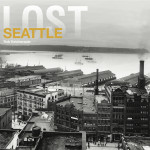Exploration of Chinatown and Japantown stations in the US, with ideas for Seattle.
- Chinatown and Japantown stations around the US
- Historic elevated structures
- Request List
1. Chinatown and Japantown stations around the US
Because of their urban location, Chinatowns throughout the United States have been included in transit systems. Many of the older transit systems in the US were built with uniform facilities, and no character was added to differentiate stations. Some of these, such as Chicago, have been retrofitted recently, and newer systems include design features to attract riders and as mitigation for the neighborhood. In-street light rail stations, bus stations, and trolley stops often have no unique identity. Here are the designs for a few Chinatown stations around the US.
 Film on windows
Film on windows
 View from tracks to Chicago's Chinatown
View from tracks to Chicago's Chinatown
Built in 1969 on Chicago's "L" elevated train Dan Ryan or Red Line. This station originally lacked any reference to Chinatown, which is only a half block away. In 2001 several design features were added after consultation with the Chinatown community.

Masks
- Design Elements:
- Tile murals with 'Welcome to Chinatown' in Chinese and English
- Lion statues
- Red and green trash cans with gold lettering 'welcome'
- Chinese artwork at platform level
- Chinese-inspired art on windows
- Chinese masks
Much of the art was created by community members, including
youth and senior groups.
Resources

LA Chinatown Station

Conceptual drawing of LA Chinatown Station
Opened in 2003, this station is on an elevated section of LA's Gold Line light rail.
The station includes a red and green roof on the platform and steps, and several pieces of artwork throughout the station. The plaza was built from original cobblestone bricks recovered in the area. Conceptual art designs by a local Asian American artist contained a gold spike, feng shui compass, and benches. The feng shui floor compass was built.
Resources
Boston MBTA Chinatown Station
Located on the T's Orange Line and Silver Line. The Silver Line is a new 'bus rapid transit' system, while the Orange Line is a subway stop on a line that has been reconfigured several times over the years. The Orange Line station is in two levels. The lower level contains a map in steel of the Chinatown neighborhood apparently dating from the 1970s renovation. The upper level was renovated in the 1990s, and does not reference Chinatown.
Washington DC MetroRail Gallery Place Chinatown Station

Art in DC's Chinatown Station
Built in 1983 on Metro's Yellow Line, much of the Gallery Place Chinatown station mimics the design of other Metro stations. In 1995 a permanent piece of neighborhood relevant art, created by a local Chinese American artist, was installed as part of a larger Metro program.
Like the LA station, this artwork is often referred to as 'colorful', and reflecting the boisterousness of the community.
Resources
New York BMT Subway Canal Street Station

Tiles on NY Canal Street Station
Canal Street Station opened in 1917 as part of the Broadway subway. During a recent renovation, Chinese symbols for luck and fortune were added to the wall tile as mosaics, as well as "Chinatown" written in Chinese characters.
Resources
Portland MAX Old Town/Chinatown station

Portland Chinatown Stop
A surface level station, Portland's Old Town/Chinatown Station serves both the MAX as well as historic trolleys. Street stations for MAX are sparse in amenities, closer to bus stops than train stations. The Chinatown sign has Chinese characters on it.
San Jose Japantown Station
Like Portland, San Jose's surface light rail is similar to a bus stop in infrastructure. There are no relevant art or design elements to the neighboring Japantown.
Resources
San Francisco Muni Chinatown Station
Phase 2 of the Third Street Light Rail project in San Francisco will include a subway terminating in Chinatown. This will be completed in 2011. No specific design plans are available.
San Francisco Cablecar Japantown Station
There is interest in expanding the California Street Cablecar to Japantown in San Francisco. No specific design plans are available.
Seattle's International District Station
Origami
Seattle's own International District Station hosts a series of art pieces depicting a piece of origami being folded. Some wayfinding is provided in Chinese nearby. Street-level structures were intended for use by the neighborhood, though that has not yet occured.
2. Elevated train stations contemporary with Seattle Pioneer Square and Chinatown/ID's buildings
While Pioneer Square and Chinatown's historic structures were being developed in the 1880s to 1920s, rail lines were being built elevated above the urban centers of Europe. Are their examples that we can draw from?
3. Request List
I would like to see the following
elements added to the overall King Street Hub Area, including Amtrak/Sounder
King Street Station, Metro/Link ID Station, Monorail Weller Station, and bus
stations:
- Chinese and Japanese route descriptions
- Instructions in Chinese, Japanese, (Vietnamese?) and English to relevant cultural landmarks (Asian Art Museum, gardens, etc)
- Neighborhood map with legends in CJVE
- Unifying thematic elements (refuse bins, phone booths, font, sign, or other design)
- I would like to see the following elements added specifically to the Monorail:
- Element of façade includes local bricks
- Perhaps exposed steel I-beams as with early 1900s infrastructure.
- Art created by community members or local Asian or Asian American artist
- Architectural elements hinting at Chinatown. Not as boisterous as LA, not as superficial and after-the-fact as Chicago.
- Be extremely careful when trying to replicate Asian concepts or cultural artifacts in non-literal uses. For example, using real lanterns may work well, but it's difficult to make a window resemble a lantern in a way that anyone will recognize
